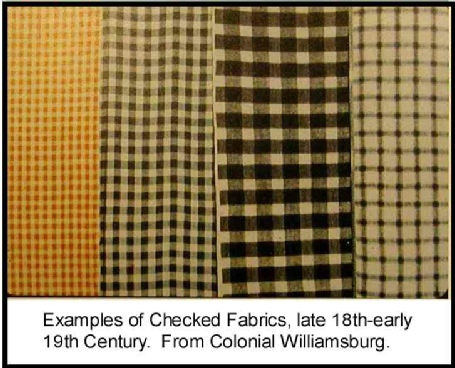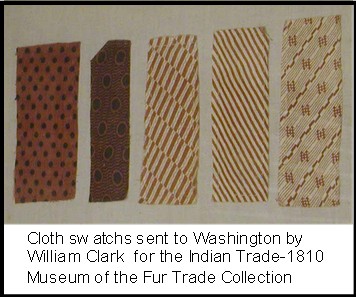Subject Guide

Mountain West
Malachite’s Big Hole
Fabrics and Sewing:
Generally every supply train was well stocked with bolts of fabric, needles, awls and other sewing supplies. These were items intended primarily for the Indian trade. Indian women were no less skillful with a needle and thread than their "civilized" counterparts. The bright colors and patterns, and soft fabrics were a desirable change from the everyday uniformity of leather clothing.
Burlap and Russian Sheeting, a coarse durable fabric similar to canvas, may have been intended primarily for the mountain men. The Russian Sheeting could be used to construct small tents and both fabrics could be used for packs and covers.
Prices shown below are costs in St. Louis.
|
No. |
Units |
Description |
Cost |
|
94 ½ |
yards |
Scarlet Cloth |
$1.65/yard |
|
21 |
yards |
Green Cloth |
|
|
158 |
yards |
Blue Cloth |
$1.625/yard |
|
42 ¾ |
yards |
Grey Cloth |
$1.44/yard |
|
26 ¾ |
yards |
Superfine Blue Cloth |
|
|
104 |
yards |
Red Flannel |
35¢/yard |
|
34 |
yards |
Dark Blue Sattinet |
82.5¢/yard |
|
24 ½ |
yards |
Dark Steel Mix Sattinet |
65¢/yard |
|
56 ½ |
yards |
French Calico |
35¢/yard |
|
54 ½ |
yards |
Scarlet Calico |
28¢/yard |
|
19 ¾ |
yards |
Fancy Calico |
20.5¢/yard |
|
31 |
yards |
Fancy Calico |
20¢/yard |
|
32 ¼ |
yards |
Fancy Calico |
23¢/yard |
|
81 ½ |
yards |
Fancy Calico |
21¢/yard |
|
1 |
|
Scarlet Melton |
|
|
1 |
|
White Melton |
|
|
73 ¾ |
yards |
Cotton Check Cloth |
15¢/yard |
|
100 |
yards |
Burlap |
|
|
|
|
Russian Sheeting |
13.5¢/yard |
|
10 |
pounds |
All Colored Threads |
15¢/pound |
|
3 |
gross |
Orange Coat Buttons |
$1.62/gross? |
|
2,000 |
each |
Needles |
|
|
2,000 |
each |
Corn Needles |
|
|
8 |
dozen |
Gilt Buttons |
|
|
1 |
gross |
Brass Thimbles |
|
Below are shown some examples of simple checked linen patterns available in the late 18th and early 19th centuries.

Brass Thimbles were favored by Indians, both as a sewing tool, and with a hole punched in the bottom as a decorative item which could be sewn on clothing and equipment.
Textiles in America 1650-1870 by Montgomery, Florence M. is an excellent source of information for the types and patterns of fabric which were available in the early 1800’s.
Back to the Top
Back To Trade Goods
